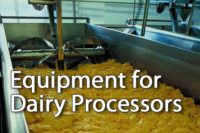
CLEANING UP
by Lynn Petrak
Comprehensive, advanced systems and supplies reflect the industry’s continued focus on sanitation.
As the food industry in general moves toward its goal of farm-to-fork efforts aimed at ensuring a high-quality and safe food supply, the processing facility itself is increasingly broken down into different segments, like links in the proverbial food chain.
In dairy settings, measures are in place from the time
tankers of raw milk back into receiving docks all the way through the
transport of packaged products.
Making sure that everything is as clean and possible
has always been an important part of dairy businesses, but given the
current intense regulatory environment, expansion of product lines,
advances in processing equipment and the advent of high-tech cleaning
systems, the axiom that cleanliness is next to godliness rings ever true.
If today’s sanitation systems aren’t
necessarily revolutionary, they are considered evolutionary. “There
are subtle changes continually happening out there,” observes Steven
Nelson, product market specialist for Nelson-Jameson Inc., a Marshfield,
Wis.-based integrated supply source for the sanitary processing industry.
Among those changes, Nelson says, is the increasing
sophistication of production lines, a trend that affects the type and
frequency of cleaning. “Although you will always have environmental
issues like cleaning and sanitizing walls, and employee hygiene, the major
change is the fact that plants are becoming so automated,” he says,
noting that sanitation supplies and services have been adjusted for such
applications, resulting in advances like clean-in-place (CIP) systems.
“Basically, as the process becomes more automated, cleaning also
becomes more automated.”
Another evolving trend in the industry with an effect
on sanitation is the emergence of dairy conglomerates.
“We’ve continued to experience consolidation in dairy, where
plants are becoming bigger and produce a wider range of products in the
same plant. That can raise true challenges for sanitation,” says
Leanne Adkins, director of dairy and beverage and R&D for Ecolab Inc.,
a St. Paul, Minn.-based global developer and marketer of cleaning,
sanitizing, pest elimination, maintenance and repair products. “The
one-size-fits-all approach doesn’t apply anymore.”
Meanwhile, keeping a lid on operating costs is a big
priority, ratcheted up in the past year with the recent fuel crunch.
“What’s driving the hydraulics of a plant is the cost of water
and energy, which is changing rapidly,” Nelson says. “Plants
want to reduce water usage and chemical usage, and they want to pick up
more processing time.”
Reducing costs while improving productivity is also
linked to the valuable resource of time, Adkins adds. “Time has
become a big issue. They are saying, “If I can clean it quicker, I
can get through more product,’” she says.
New Solutions
As the dynamics of the dairy business evolve, the
method by which things are cleaned has also progressed. To boost
efficiency, processors are using new technologies and, in some cases, new
applications of existing technologies.
The use of CIP systems is just one example; other
adjustments are going on as well. Nelson-Jameson, for instance, has begun
selling more industrial vacuums to dairy operators. “Typically this
industry has done what we call ‘wet cleaning,’ and that may be
using a CIP system or a foamer, but it’s always been chemically
related,” Nelson says. “Now, they may have a situation where
they are dealing with powder and want to reduce the growth load, and
reducing the load with vacuums seems to work well.”
Nelson-Jameson has pursued other new applications for
use in dairy facilities, such as the company’s new line of
single-cycle cleaners for hydraulics. “You can reduce the number of
cleaning cycles and rinse cycles,” Nelson says of the technology,
which was introduced in Europe.
Also reflecting processors’ interest in cutting
out extra steps, Nelson-Jameson has developed cleaners that are more
versatile. “Typically, you rely on alkaline cleaners to remove fats
and oil and acids to remove minerals,” Nelson says. “With this
new product, you can remove both simultaneously.”
Ecolab also has developed new products and services
that address the demand for efficiency. One new platform is an expansion of
the company’s Exelerate™ series of dairy-processing cleaners designed for the
pre-treatment of heat exchange surfaces. “We are seeing enhanced
cleaning performance with shorter cleaning time,” Adkins says of the
system often used on HTST pasteurizers.
In early 2007, Ecolab will roll out a similar product
for use with evaporators. In addition to efficiency, a new line of
sanitizers from Ecolab have other benefits, Adkins reports.
“We’ll be able to monitor and control the sanitizers via
conductivity,” she says, “and that is new to the
industry.”
Waste Not
Dairies are also looking beyond the just processing
side of their operations. For example, many government regulations have
zeroed in on the quality of wastewater.
“One thing that has evolved in recent years is
the regulations surrounding cleaning products and what plants can release
into the environment,” Adkins says. “There are restrictions on
sodium, phosphate and the whole effluent, water-in/water-out
cycle.”
To address such issues, Ecolab has a special water care
division. “We are trying to formulate solutions that take those
restrictions into account, with things like lower sodium and less
phosphate. The thing that becomes the challenge, though, is that many times
those can be the workhorses in cleaning, so it’s a question of how
you come up with environmentally friendly chemistries that give you more
time and cleaning efficiency,” Adkins says, noting that Ecolab has
spent considerable R&D time on solutions to such issues. So far, she
says, the wastewater issue remains one that varies by region. “There
are pockets were the restrictions are worse and you have to look at it on a
state by state basis,” she says.
Nelson agrees, saying Nelson-Jameson is also working
with dairy customers on balancing sanitation needs and regulations
regarding wastewater. “There are different stringencies to it and
some states are more sensitive than others. Personally, I feel that in
places that have volumes of water available, the key is keeping that water
clean and sanitized for everyone,” he says.
Procorp Inc., Wauwatosa, Wis., works with dairy
processors on wastewater issues. “Where we get involved is in taking
wastewater from a factory and purifying it by standards set by local and
state governments,” explains company president Tom Probst. In
addition to helping plants minimize water usage, Procorp provides
suggestions for cleaners and sanitizers that reduce the concentration of
elements like phosphorus and helps plants in the recovery of certain
chemicals. The company also continues to offer new products for
manufacturing plants like dairies, such as a new water softening process
that removes chloride from the effluent.
$OMN_arttitle="CLEANING UP";?>
